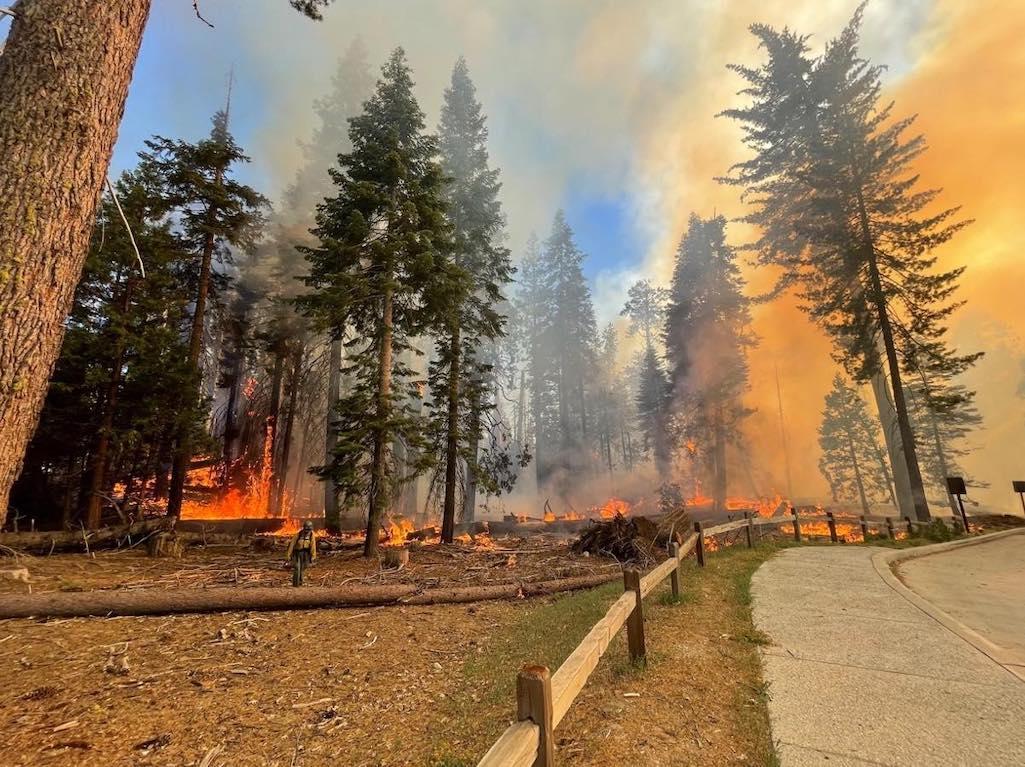
A wildfire was burning Saturday near the Mariposa Grove of Sequoias in Yosemite National Park/NPS
Editor's note: This updates acreage under fire and provides additional background on wildfires in the West.
Yosemite National Park's famous Mariposa Grove of Giant Sequoias was threatened Saturday by a growing wildfire that led to the evacuation of not just the grove but the nearby Wawona area. While more than 200 firefighters were trying to tackle the 703-acre Washburn fire, weather conditions were not helpful, as the forecast called for growing temperatures and reduced humidity through the weekend.
The cause of the fire had not been determined. The blaze, which was reported Thursday afternoon, seems to reflect the new normal of fire behavior in Western units of the National Park System. Not only are fire seasons lasting longer, but this year they are starting earlier, at least in New Mexico, where prescribed burns conducted by the U.S. Forest Service erupted into massive wildfires.
Back in May, James Wallman, a meteorologist in the National Interagency Fire Cache in Boise, Idaho, told the Traveler that current trends portended a smoky summer. Whether this is the "new normal" for fire season in the West remains to be determined, he added.
"What's the new normal? We don't know because everything is still changing," he said. "How do we adapt to it? How do we think about all these things? How do we tell people what's going on? I think what we're seeing is what is consistent with what is being predicted with climate change."
Last year's fire season saw 7,125,643 acres burned nationally, a drop from 2020 when 10,122,336 acres burned. However, in Northern California, some fires grew "to enormous size, causing the overall acreage burned to significantly exceed the area's 10-year average," according to the National Interagency Fire Cache's annual summary of 2021's fire activity.
Foremost among last year's fires were the KNP Complex that raged through Sequoia and Kings Canyon national parks, charring nearly 90,000 acres, and the Dixie Fire, which consumed nearly 1 million acres and burned south to north through Lassen Volcanic National Park and claimed the park's historic Mount Harkness fire lookout.

Smoke from the Washburn fire as seen from the Wawona Hotel/Lindsay Stevenson
In Yosemite, significant amounts of downed timber and mixed timber forest were fueling the Washburn fire, which was named after a nearby hiking trail. The Wawona Road [Highway 41] south of Yosemite West, and the Mariposa Grove were closed until further notice. Reinforcements were being called in and expected to arrive in the coming days.
It was not clear how far the fire was burning from the Mariposa Grove of Giant Sequoias, which counts more than 500 mature sequoias. Calls to both the fire public information office and Yosemite's public affairs office went to voicemail and were not immediately returned Saturday morning.
Giant Sequoias can grow to be 300 feet high, 35 feet in diameter and 100 feet in circumference. One of the grove’s largest trees, the Grizzly Giant, is 209 feet tall and an estimated 1,800 years old. In the grove, firefighters reportedly were wrapping sequoia trunks with a fire-resistant material.
It's not an overstatement to say the sequoia groves in California are being tested like never before by a combination of climate change-driven drought, insects, and wildfire. Devastating wildfires have spiked since 2015, culminating in 2020's fire-season inferno that burned more than 4.3 million acres of wilderness, rural areas and communities across California, the most ever recorded. In a little over a century, from 1910 through 2014, wildfires burned 25 percent of the giant sequoia range, forest and fire ecologist Kristen Shive found when analyzing the state’s Cal Fire data. Then in 2015 through 2020, wildfires burned 65 percent of the range: 2020 alone accounted for half of that, 16,000 grove acres, dwarfing the 1910-2014 combined acreage burned.
Last year's wildfires that seared Sequoia and Kings Canyon national parks and neighboring Sequoia National Forest claimed between 3 percent and 5 percent of the world's giant sequoias, according to the National Park Service. In simple numbers, the losses fall between 2,261 and 3,637 mature sequoias with a diameter of at least four feet.




 Support Essential Coverage of Essential Places
Support Essential Coverage of Essential Places







Comments
Well, the environmentalist's Mecca is burning.... Maybe they should have listened to the Sierra Club's founder and guru......."The underbrush and young trees will grow up as they are growing in Yosemite, and unless they are kept under control the danger from some chance fire ... will become greater from year to year. The large trees will then be in danger."" He closes saying: ""Forest management must be put on a rational, permanent scientific basis, as in -every other civilized country."-- John Muir